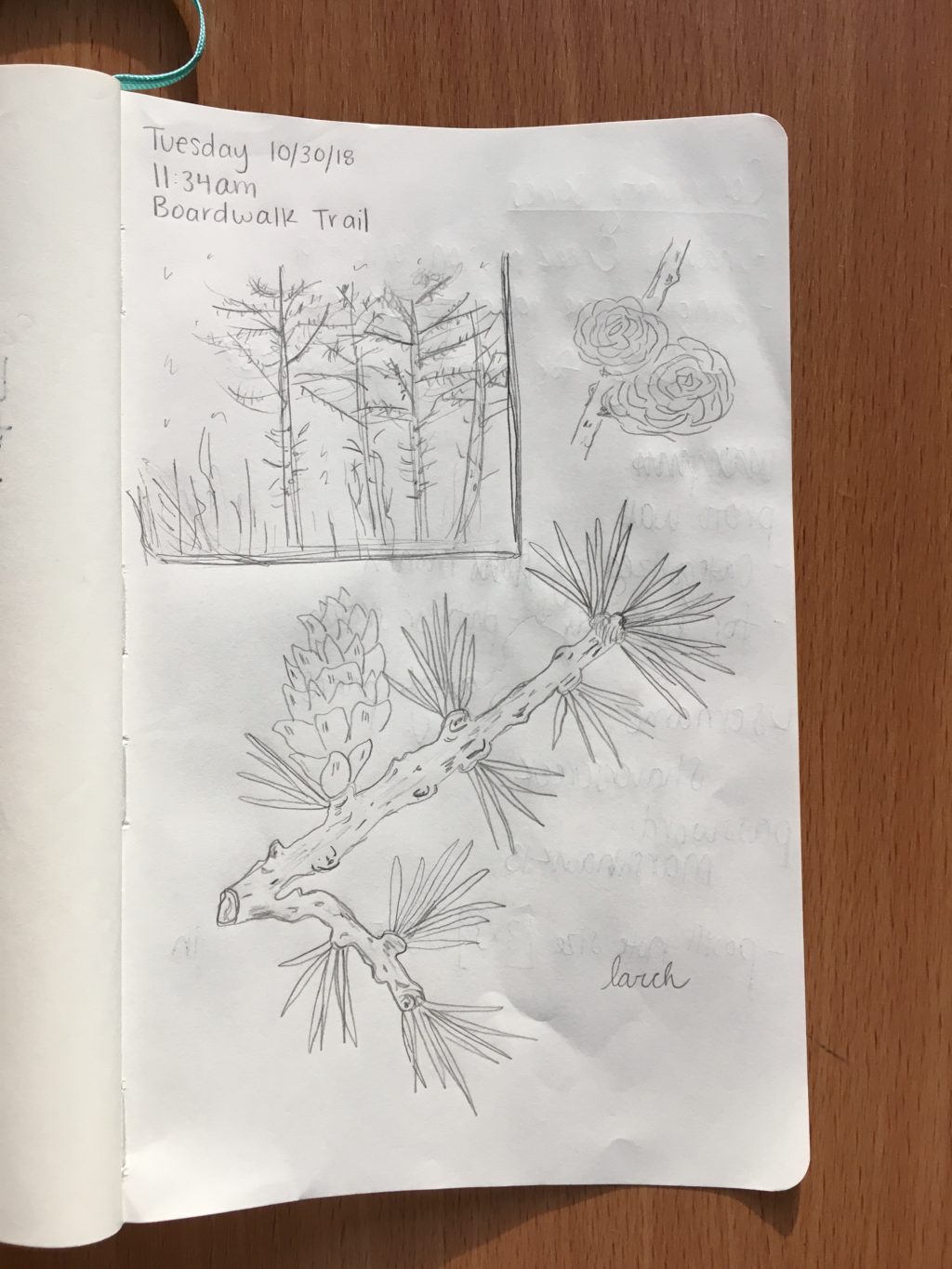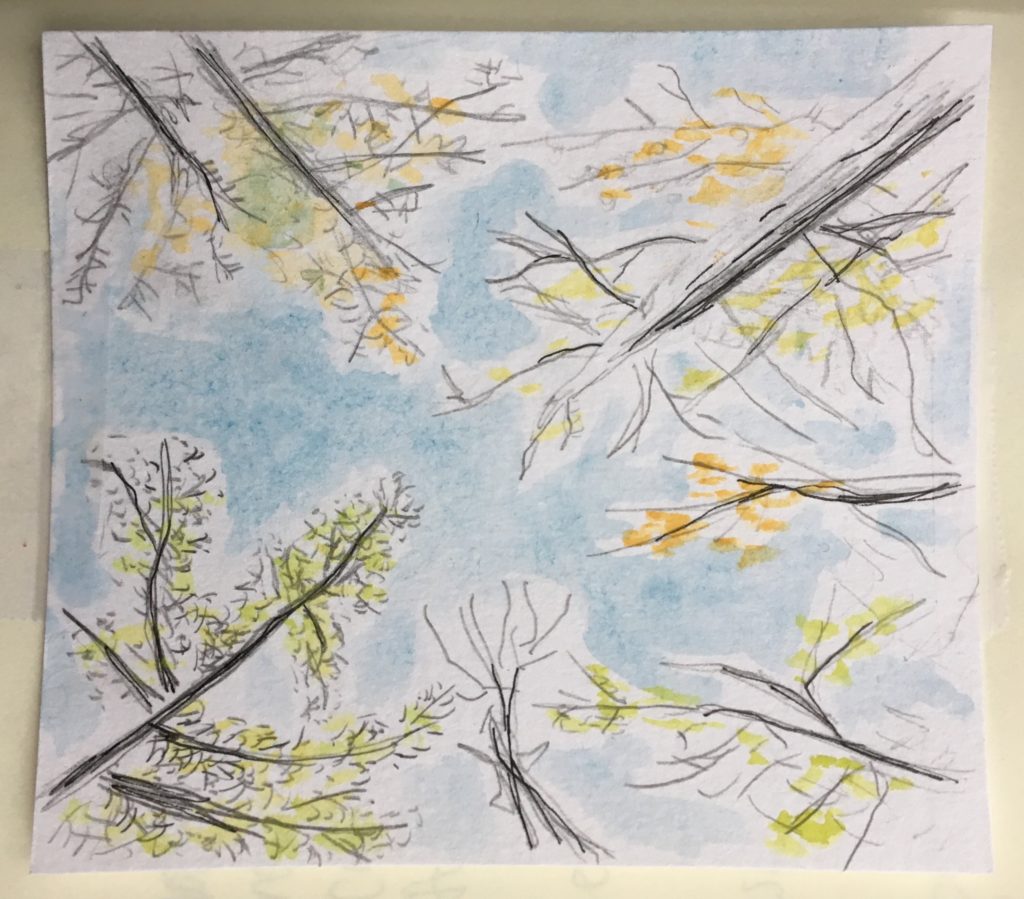Monday began with a morning meeting, heavy eyelids, and the prospect of a rainy week. As I walked through Silvi classroom, passing by the cushy chairs of the bird-feeder watching station, my eyes caught a glimpse of the colorful cover of a book I had never seen before, Keeping a Nature Journal: Discover a Whole New Way of Seeing the World Around You. A large paperback covered in brightly shaded sketches of leaves and fruits: maples, oaks, and pears.
What could I accomplish if I attempted to keep a nature journal for just one week? The idea, however daunting, seemed reasonable enough. According to my calculations from sixth grade health class and creating S.M.A.R.T goals, it seemed as though this was one worth striving for.
So there I was, day one, about 46 degrees and cloudy, wind whipping through the near-empty forest canopy, as a mist of rain pelted almost sideways between the posts of the lakeside pavilion. I looked out across the water as I quickly pondered what would be the easiest thing to sketch as my fingers grew numb. The pine tree across the lake? The low lying shrubs creeping up beside the railings of the deck? I soon settled on a quick sketch of the landscape itself, a crude scribble of water, land, and sky, attempting to give depth to the areas my eyes could barely reach.
“In this 20th century, to stop rushing around, to sit quietly on the grass, to switch off the world and come back to earth, to allow the eye to see a willow, a bush, a cloud, a leaf… I have learned that what I have not drawn I have never really seen.”
I closed my journal and shoved my shivering hands back into the pockets of my now damp down jacket. One last look up at the view and I couldn’t help but realize that it was entirely true. Those few focused minutes had forced me to realize the curve of the shore, and how it bends in line with the waves of the water, the great white pines behind the recreation building and how their towering effect makes their counterparts seem so small. A friend of mine, one who makes art for an actual living, once told me about an inspiring professor they had in college who shared with them the idea of gratitude. She encouraged her students to give thanks to a beautiful landscape whenever they felt necessary. This could be gifted in a number of ways, a smile, a bow to the earth, or my personal favorite, arms stretched out, face pointed towards the sun, shouting “THANK YOU!” to all that could hear.
This time, accompanied by a fellow intern, I kept my shouts silent and thought a quiet “thank you” coupled with a knowing smirk.
——————-
The Medicine Wheel has been used by generations of various Native American tribes for health and healing. The wheel was initially designed as a conflict reducer, a foundation for peace. With four intersecting directions, the wheel is a reflection of an individual’s strengths and weaknesses and a guideline to follow for personal growth. It told people what they needed to learn and what they needed to teach based on who they were. Individuals tend to lean towards one or two directions, holding a healthy blend of values and ideas, or maybe (some say) true enlightenment is found within a balance of them all.
Tuesday morning began with a discussion of this topic. A fellow intern crouched in his desk chair, reading aloud the four directions and what they symbolize, deciding where each of us fell. According to a Google search and a less-than-professional looking PDF titled “Team Types: Four Personality Traits in Team Building- The Native American Medicine Wheel”, our fate laid before us. Before even hearing my options, I was quickly deemed an “East” by my peers.
North, South, East and West read in large bold lettering on the screen, each followed by a bullet-pointed list of traits such as “very idea oriented” or “likes to be in control of relationships and steer course of events.” Being cornered into an East made me defiant against it, naturally. But which direction’s traits did I ultimately end up connecting with the most? Those true of any aspiring journal-er, of course: “visionary who sees the big picture,” “likes to experiment and explore,” “can lose focus on tasks and not follow through,” and “tends to be highly enthusiastic early on, then burn out.” East.
And so, Tuesday, we focus on… focusing.
We set out on the same mission as the day before, to walk and wander, and to attempt to see what we would usually miss. Our numbers grew, two additional interns coming along for the ride. Sometimes your field of view can become quite narrow, a consequence of observing too closely. Naturalists can fall victim to this. While appropriately timed laser-focus is beneficial, an East would argue the importance of seeing the big picture. So, again, there I was. Shuffling down the Boardwalk path, journal in hand, eyes glued to the forest floor absentmindedly scanning for shimmers of red, gold, and yellow hues. “Around this time of year the larches are about to turn my favorite color,” I heard, mumbled quietly as we turned the corner. My head spun around, back down the trail, as I strained my vision up, and up, and up, peeking through squinted eyes at the giants illuminated in the midday sun. Two larches, paralleling each other as they rose above their outshadowed neighbors, turning shades of green-yellow to bright golden. Two larches, on a path that I thought I knew so well. Two larches that I had never seen before. I let my eyes shut for a moment. “Thank you.”
——————-
I think journaling can fall on a spectrum, ranging anywhere from completely private and hidden in your bedside table drawer to posting it loud and clear on a community blog. Whichever suits your fancy, it’s important, and valuable, to find comfort in your preference and recognize what you need.
Today, I was tired. I needed more silence than it seemed like the outdoors could offer. I settled on a picnic bench a few yards from the shore, looking out towards the pavilion where I stood just a few days prior. It was warmer than it had been in a while. Unzipping my jacket, I let my eyes focus vertically, up towards the natural framing of canopy cover allowing me to see straight into the clouds. They darted by, whispering insights of an approaching storm. My legs dangled off the side of the table, swinging back and forth to the beat of a familiar song, as I laid back on the wooden slats sprinkled with leftover bird remains, too lazy and content to care.
——————-
I couldn’t have been much younger than 19 when I built my first fire. A novice outdoorswoman tasked to start one for a Wednesday night program. I’ll spare the details of that wild success story but share with you that there’s a certain sense of accomplishment that comes with the act. Whether it be the (ideally) instant gratification of catching flame or the slow burn of coals pulling people in to stay just a little bit longer.
We trickled in here and there, sliding laptops and notebooks onto the thick wooden table. A quiet Thursday at Shaver’s Creek, now accompanied by the soft crackle and pop of some roasting logs. I couldn’t explain to you the exact science behind it, but I do know that the draw of a fire is one that brings people together.
“Shaver’s Creek Environmental Center is committed to extending the University’s Outreach mission of instruction, service, and research. Through quality programs, we teach, model, and provide the knowledge, values, skills, experiences, and dedication that enable individuals and communities to achieve and maintain harmony between human activities and the natural systems that support all living species.”
Lightly put, Shaver’s Creek strives to connect people to people, and people to nature. On a quiet Thursday by the fire, I think we have.
——————-
About a month ago I had met with our intern coordinator to discuss my goals for the season. He shared his wisdom as I quickly scribbled down notes of what I could interpret from his words. A few weeks later now, I revisited those pages. “What is your motivation?” was jotted down at the bottom of the page. I followed that with, “To find a sense of place, a home here.”
Recently, I’ve struggled with the idea of how to make the most of my days. Fall passes quickly, but this week was different. I didn’t quite sit idle, waiting for nature to present itself to me. Rather, I made the effort to be present, be intentional, be mindful. So here’s what I’ve learned, all summed up into one answer you maybe already knew: how do you make the days last longer? Pay attention to them.






